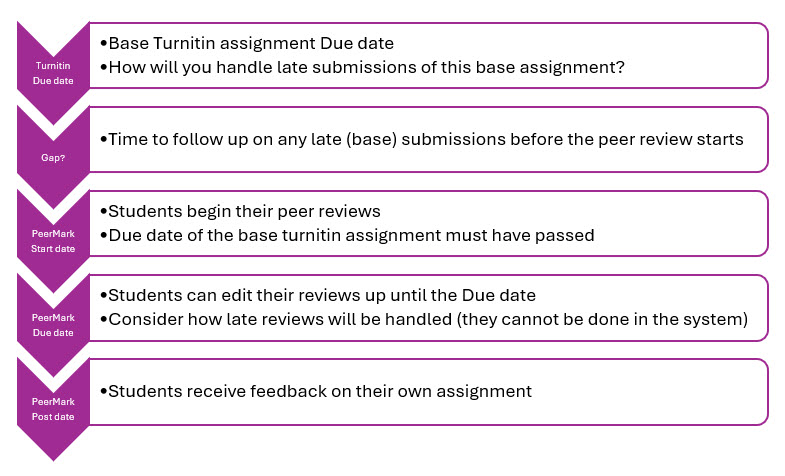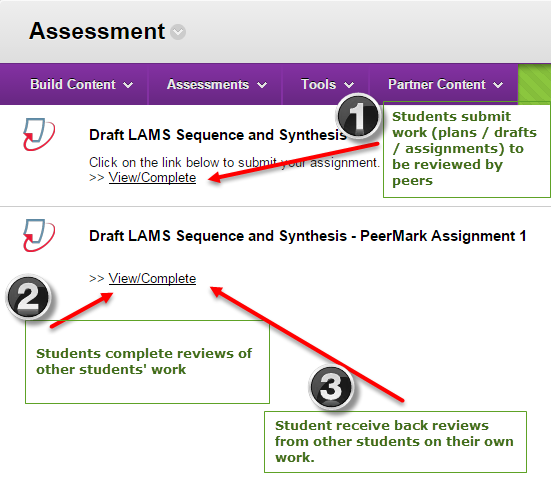Overview of Turnitin Peer Mark (Original)
What is Peer Assessment?
“Peer assessment is defined as an arrangement in which individuals consider the amount, level, value, worth, quality, or success of the products or outcomes of learning of peers of similar status” (Topping, 1998)
“Peer assessment is the assessment of students' work by other students of equal status.” https://teaching.unsw.edu.au/peer-assessment
What is Turnitin PeerMark?
PeerMark is an online tool for distributing student work for peer review. The steps involved are:
- The course coordinator creates a Turnitin paper assignment.
- Students submit work to be reviewed the same way as they normally submit a Turnitin assignment.
- The course coordinator creates a PeerMark assignment.
- Sets the number of assignments students will be required to review.
- Creates free response and likert scale questions for students to respond to while reviewing assignments.
- Students begin writing reviews on the PeerMark assignment start date (after the base Turnitin assignment due date has passed)
- Students review the assignments of their peers they have been assigned, answering the free response and likert scale questions.
- Students can edit their review up until the due date.
- Peer feedback will be released immediately as students complete reviews, therefore students will be able to view the feedback they have received on their own assignment once reviews have been submitted.
- Grading the peer reviews (refer to Mark Reviews guide):
- If Award full points if review is written was not selected when creating the Turnitin PeerMark assignment, the course coordinator will need to mark all students on the quality of their peer reviews.
- If Award full points if review is written was selected when creating the Turnitin PeerMark assignment, students will automatically recieve the total Points value if they answer all questions when writing reviews and the course coordinator will not be able to grade the reviews.
- After student peer reviews have been graded, by either automatically awarding full points or the course coordinator marking students themselves, the final grade will populate through to Grade Centre. Once the Grade Centre column has been made available, students will be able to view their overall mark for the quality of their peer reviews through My Grades.
Types of Peer Assessment
There are a wide variety of way to implement peer assessment. Consider the following:
- What will be assessed?
- Assessment plans
- Assessment drafts
- Final products
- Will the peer assessment for formative OR summative?
- If the peer assessment is summative what do students receive marks for?
- Students receive marks allocated them by their peers (not possible in Turnitin PeerMark).
- Students receive an automatic mark for completing a review (possible in Turnitin PeerMark).
- Students receive marks for the quality of their reviews (possible in Turnitin PeerMark).
Benefits
Additional feedback
- Peer assessment has the benefit of providing students with additional feedback without the associated teacher workload considerations. (Gielen et al., 2011)
- “Peer assessment appears capable of yielding outcomes at least as good as teacher assessment and sometimes better” (Topping, 1998)
- Imperfect feedback that is timely and informs the learning process is more worthwhile than “perfect feedback from a tutor four weeks later” (Gibbs and Simpson, 2004-2005)
- Two reviewer could be used to improve reliability. (Mostert and Snowball, 2013)
Engagement
Peer assessment gives students the external motivation and pressure to produce quality work due to the fact that it will be assessed by peers, rather than a more anonymous tutor or course coordinator (Gielen et al., 2011)
- Students spend more time on task, need to take on an active learning mode and engagement is increased (Thuy Vu and Dall’Alba, 2007; Mowl and Pain, 1995; Smith, 2012)
Taking on the role of assessor
- The experience inherently encourages self-reflection and helps them critically judge their own work (Nicol, 2010)
- The experience also helps students understand assessment criteria and thus improve their own academic performance (Mowl and Pain, 2006)
Building a learning community
Development of skills related to “collaboration, teamwork, and becoming a member of a learning community” (Boud, Cohen & Sampson,1999)
Logistics questions
Before setting up your Turnitin PeerMark assignment, you will need to make the following decisions:
- What type of assessment is being reviewed (assignment plan, assignment draft, final assignment)?
- Is the peer assessment task summative or formative?
- Will you need to allocate small % to the peer review to ensure students complete it?
- Do students automatically receive a mark for completing the review/s?
- Do students receive a mark based on the quality of the reviews they give?
- How many submissions should each student review?
- Should they review their own (i.e. self-assessment)?
- How will students be allocated submissions to review?
- Randomly - automatically by Turnitin PeerMark
- Course coordinator – manually set up all pairs in Turnitin PeerMark
- Student – students select submissions to review.
- Will the process be anonymous? If anonymous you will need to ensure students to do not include their names in the submitted assignment.
- Should students who have not submitted an assignment be able to review others’ submissions?
- How will you cater for students with extensions (or late)? A different manual system?
Timeline
It is important to plan the timeline of your peer assessment task carefully and ensure that students are aware of the multiple date dates.

Design of questions
You need to consider the following options when planning your review questions
- Likert Scale / Free response?
- Applying the criteria of the final assignment?
- Scaffolding of questions.
- Minimum word length?
- Use of the annotation tools?
References
Boud, D., Cohen, R., & Sampson, J. (1999). Peer learning and assessment. Assessment & Evaluation in Higher Education, 24(4), 413-426.
Gielen, S., Dochy, F., Onghena, P., Struyven, K., Smeets, S. (2011). Goals of peer assessment and their associated quality concepts. Studies in Higher Education, 36(6), 719-735.
Gibbs, G., & Simpson, C. (2004-2005). Conditions under which assessment supports students’ learning. Learning and Teaching in Higher Education, 1, 1-31.
Mostert, M., & Snowball, J. D. (2013). Where angels fear to tread: Online peer-assessment in a large first-year class. Assessment & Evaluation in Higher Education, 38(6), 674-686.
Mowl, G., & Pain, R. (1995). Using self and peer assessment to improve students’ essay writing: a case study from geography. Programmed Learning,32(4), 324-335.
Nichol, D. (2010). From monologue to dialogue: improving written feedback processes in mass higher education. Assessment & Evaluation in Higher Education, 35(5), 501-517.
Smith, M. (2012). Can Online Peer Review Assignments Replace Essays in Third Year University Courses? And if so, What are the Challenges?. Electronic Journal of e-Learning, 10(1).
Topping, K. (1998). Peer assessment between students in colleges and universities. Review of Educational Research, 68(3), 249-276.
Vu, T. T., & Dall’Alba, G. (2007). Students’ experience of peer assessment in a professional course. Assessment & Evaluation in Higher Education, 32(5), 541-556.

